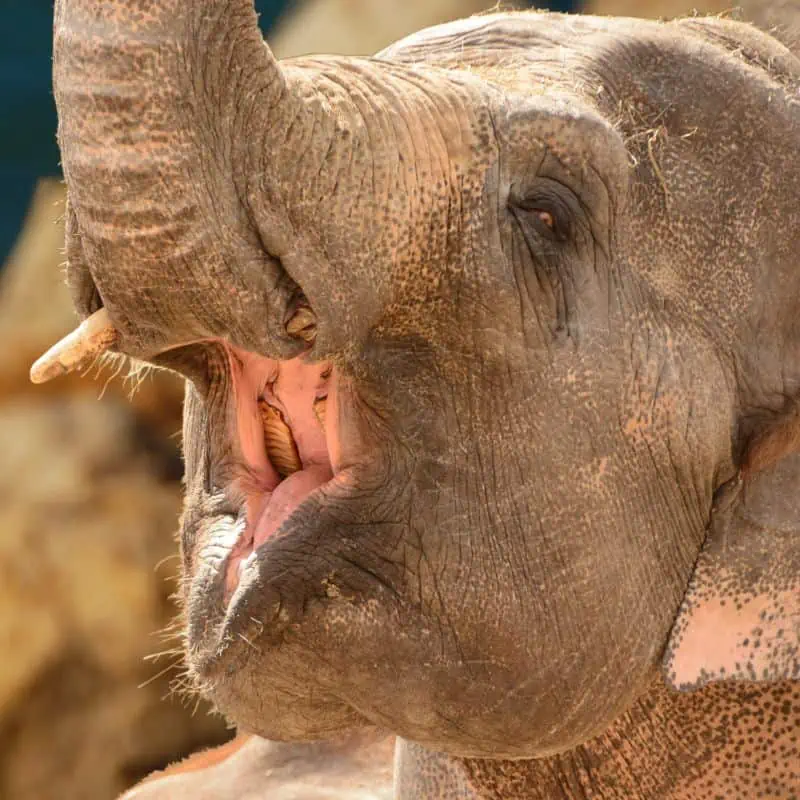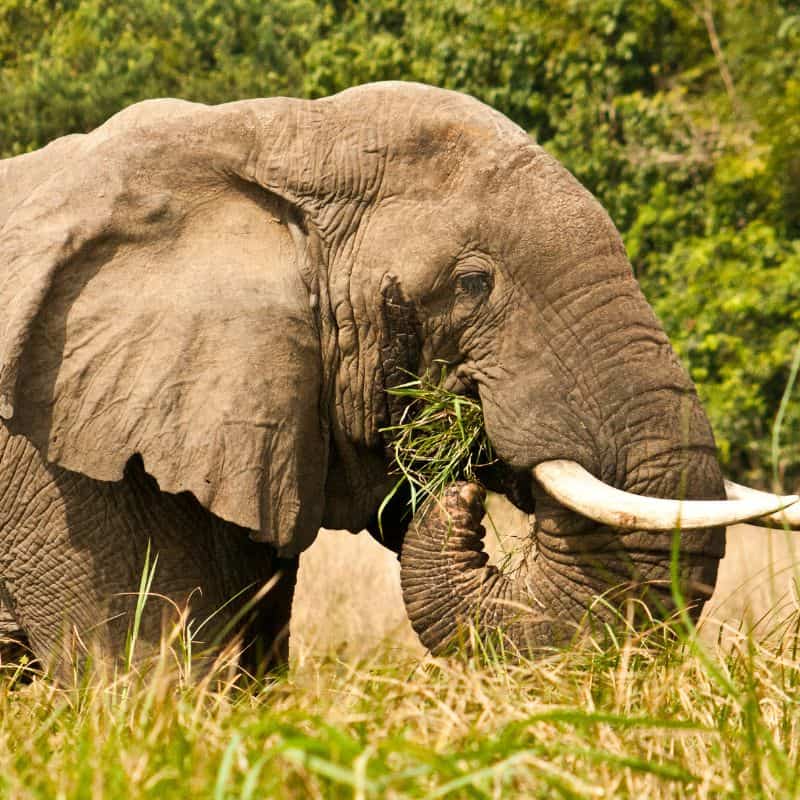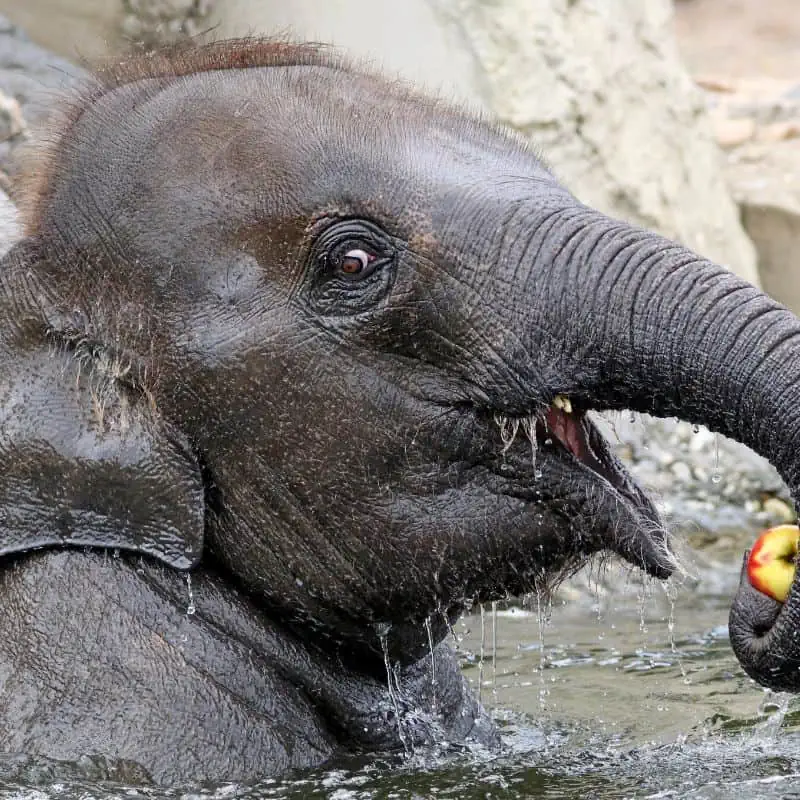With an elephant spending 20+ hours chewing food, you may wonder about its teeth’s strength and nature. How do elephants manage to eat so much without wearing down their teeth? How many teeth do they have?
Elephants have 26 teeth; 2 incisors called tusks, 12 premolars, and 12 molars. The premolars and molars grow in six sets of four teeth throughout their lives. On the other hand, the tusks are permanent and only grow once after the milk ones fall out. The molars and premolars are the sizes of bricks, and the tusks grow up to 6 feet.
In this article, we’re going to look into the unique dentistry of elephants; let’s get started.

How Many Teeth Does an Elephant Have?
All elephant species, including the African and Asian, have 26 teeth. They have two upper incisors called tusks, 12 wide, flat molars, and 12 slightly narrower, pointier premolars.
Keeping in mind that elephants are herbivores, it makes sense for most of their teeth to be molars and premolars. These flatter teeth allow them to grind up plant matter easily.
They don’t have canines or sharper teeth, as they do not need to tear through flesh and meat.

Different Types of Elephant Teeth
Here is a breakdown of the different types of elephant teeth and their uses.
1. Tusks
Elephants have two tusks which are modified elongated incisors made of ivory. These teeth continue growing throughout their lives.
The tusks are enormous. They are way bigger than what is visible to the human eye, as one-third of them are embedded deep into the elephant’s head.
They have the same three components as human teeth,
- A pulp cavity containing nerves, blood, and tissues is present in the embedded part of the tusk.
- Dentine is a part of the visible tooth.
- Enamel is the hard covering protecting the tooth.
It’s common for some species of elephants not to grow tusks. For example, female Asian elephants do not have them. Additionally, some of the male Asian elephants also do not grow tusks. On the other hand, both male and female African elephants have tusks.
The tusks are used for ripping bark and digging up roots. They are also used to move things that are blocking the way.
Additionally, males also use their large tusks to intimidate other males during the mating season. They may even use them to fight with others over territory or food.
Moreover, like humans can be left or right-handed, elephants can be left or right-tusked. They can favor one tusk over the other and use it more frequently.
Using only one tusk for tasks makes it worn down, while the unused tusk remains in perfect shape.

2. Premolars and Molars
Elephants have twelve premolars and twelve molars in total.
These 24 teeth grow in six sets of four teeth. The elephant uses them for grinding vegetation and plant matter.
The molars and premolars have textured ridges that help break down plant matter. The shape of the ridges is frequently used to distinguish between African and Asian elephants. The former has diamond-shaped ridges on its teeth, while the latter has more cylindrical-shaped ridges.
Arrangement of Elephant Teeth
As mentioned above, the two tusks are embedded deeply in the head of the elephant.
The other 24 teeth, including the premolars and molars, grow from the back of their jaws. Once the current teeth get worn down and fall off, the new teeth growing in the back take their place.
The 24 premolars and molars are equally divided between the four quadrants of an elephant’s mouth; upper-right, upper-left, lower-right, and lower-left.
So, six teeth grow in each quadrant throughout the elephant’s life.
Tooth Dimensions
Like their body weight, elephants have large teeth that weigh quite a lot.
The size of the molars is roughly the same as bricks, and each weighs approximately 4.5 pounds.
The tusks are even bigger and grow up to 6 feet in length. These huge teeth weigh 50-100 pounds each.

Milk Teeth
Baby elephants are born with four small molars and premolars and two baby tusks.
The six teeth fall out in two years. They are then replaced by an adult set of four flat teeth and two incisors.
Do Elephants Grow New Teeth?
Unlike humans and other mammals that grow milk teeth and replace them with a single set of permanent adult teeth, elephants grow six sets of four flat teeth throughout their lives.
Their teeth get worn down by the enormous amounts of vegetation they eat. So, the older teeth fall off after a couple of years and get replaced by new teeth.
However, the tusks only grow once after falling out. They do not fall out and get replaced by new teeth like the molars and premolars.
Here is a breakdown of the six teeth sets that elephants grow throughout their lives.
- The first set, i.e., the milk teeth, falls out by age two.
- The second set replaces the first one and falls out once the elephant reaches the age of 4-6 years. It includes four molars and premolars, and two tusks. While the molars and premolars of the second set fall out, the tusks do not, as they are permanent. Elephants will not grow new ones if they are lost.
- The third set grows around the ages of 4-6 and falls out once the elephant becomes 9-15 years. It includes four molars and premolars.
- The fourth set replaces the third one and falls between 18 and 28 years old. It includes four flat teeth.
- The fifth set lasts until the elephant is 40.
- The final set, i.e., the sixth set, lasts for the rest of the elephant’s lifetime.
Once the sixth set falls off, the elephant won’t grow a new set.
So they will be unable to eat and eventually die. Loss of teeth is one of the significant causes of death in older elephants.
Final Thoughts On Elephant Teeth
Elephants have unique teeth that aren’t like any other mammals.
From their modified incisors to their unusual cycles of tooth rotation, these gentle giants continue to amaze our minds with their remarkable features.
FAQs
What Are Elephant Tusks?
The tusks of an elephant are teeth. They are modified incisors made up of pulp, dentine, and enamel. Elephants use them to rip bark, dig roots or remove obstacles from their path.
What Type of Teeth Do Elephants Have?
Elephants have 26 teeth in total. 2 are incisors, 12 are premolars, and 12 are molars. Most of an elephant’s teeth are molars or premolars as they need flat teeth for grinding plant matter.
Do All Elephants Have Tusks?
All elephants do not have tusks, as they don’t play an essential role in chewing food. While all African elephants have tusks, female Asian elephants do not. Additionally, several Asian males also do not have tusks. The loss of tusks is thought to result from a genetic mutation to protect elephants from ivory poaching.
